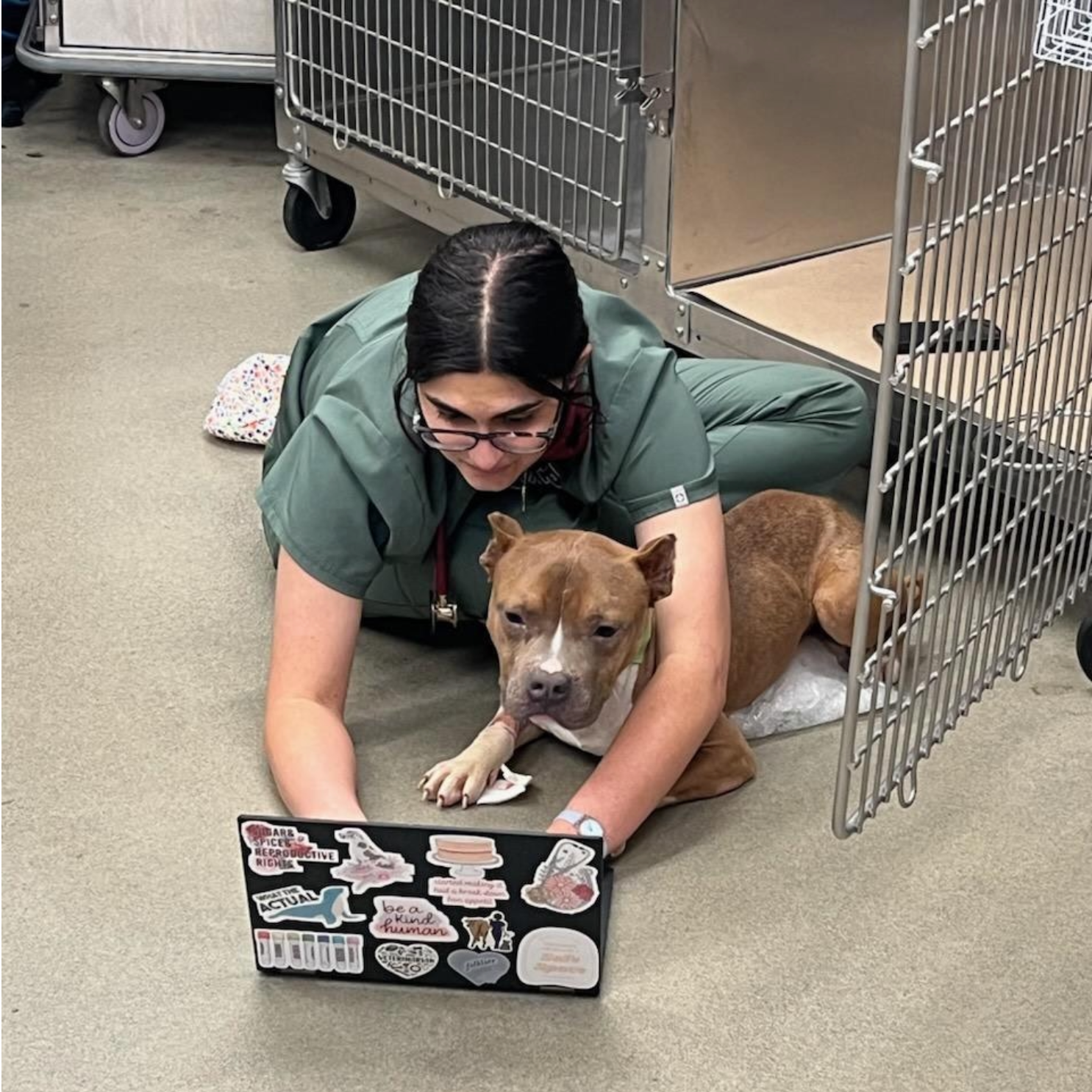Diabetes In Dogs

Diabetes in Dogs
Diabetes is a serious but manageable condition that affects many dogs. Just like in humans, diabetes can lead to long-term complications if left untreated. That’s why early detection and consistent care are important for helping diabetic dogs live healthy lives.
What is diabetes?
There are two main forms of diabetes that occur in dogs: diabetes mellitus and diabetes insipidus.
Diabetes mellitus is the most common type and is caused by the body’s inability to produce enough insulin (predominantly) or an inability to use insulin effectively. Insulin regulates blood sugar levels (glucose) in the body by facilitating the movement of sugar obtained from food into the body's cells to provide them with energy. Without adequate insulin levels or the ability of the body to respond to insulin appropriately sugar builds up in the blood, resulting in high blood sugar (hyperglycemia).
Diabetes insipidus, on the other hand, is a rarer form of diabetes that involves a problem with water balance in the body rather than blood glucose control.
The information provided here specifically addresses diabetes mellitus.
How common is diabetes in dogs?
Diabetes is relatively common in dogs, with a reported worldwide prevalence ranging from 0.2-1.2%, with certain breeds and age groups being more susceptible. Diabetes typically occurs in middle-aged and older dogs, with certain breeds like Dachshunds, Poodles, Australian Terriers, Schnauzers, Cavalier King Charles Spaniels and Beagles at higher risk of developing diabetes. Puppies can also develop a rare form of diabetes, known as congenital diabetes.
What causes diabetes in dogs?
There are a number of suspected or confirmed factors that might result in diabetes in dogs:
- Genetic predisposition: Some breeds are genetically more likely to develop diabetes including miniature poodles, Bichons Frises, Pugs, Dachshunds, Miniature Schnauzer, Samoyeds, Keeshonds, Australian Terrier, Fox Terriers, Cairn Terriers and Beagles
- Obesity: Overweight dogs are likely to have reduced insulin sensitivity.
- Sex: Unspayed female dogs are twice as likely as male dogs to have diabetes
- Autoimmune disease: In some cases, the immune system can mistakenly attack the insulin producing cells in the pancreas resulting in impaired insulin production
- Hormonal imbalances: Hormonal conditions like Cushing’s disease, hypothyroidism or even altered growth hormone levels (which can occur in certain phases of a female dog’s estrus cycle or due to a condition called acromegaly) are associated with diabetes development.
- Drugs: Certain drugs, especially corticosteroids if used for prolonged periods, are associated with increased risk of developing diabetes.
- Pancreatitis: Chronic inflammation of the pancreas can also damage insulin-producing cells in the pancreas.
What are the signs of diabetes in dogs?
Recognizing the early signs of diabetes in dogs is most important for timely diagnosis and treatment. Common signs include:
- Increased thirst (polydipsia): A dog with diabetes will often drink a lot more water.
- Frequent urination (polyuria): Due to the excess glucose in their bloodstream, diabetic dogs tend to urinate more frequently. A dog may ask to go outside frequently and may start having accidents in the house.
- Weight loss: Despite eating normally, dogs with diabetes often lose weight as their bodies are unable to use glucose for energy production, resulting in the body breaking down fat stores more rapidly than normal.
- Increased appetite (polyphagia): Many diabetic dogs become hungrier because their bodies are not able to access the energy provided from their food like normal.
- Lethargy: Dogs with unmanaged diabetes will often show signs of weakness or low energy.
- Cloudy eyes: In diabetes, high amounts of glucose enter the lens, are transformed into sorbitol which attracts an excess of water into the lens and causes cataracts (cloudy/white eyes). Cataracts can result in reduced vision or complete blindness as signs progress.
- Persistent or recurrent infections: Diabetic dogs are often at increased risk of infections, especially urinary tract infections.
If you notice any of these symptoms, visit us early diagnosis and treatment can help manage the condition and prevent further complications.
How do we diagnose diabetes in dogs?
Diagnosing diabetes in dogs starts with a physical exam but will also often require blood tests and urine tests. It's likely that your pet will receive a comprehensive blood test to check a range of parameters which may include a:
- Blood glucose: This test measures the amount of glucose (glycemia) in your dog’s blood. Persistent hyperglycemia (high blood glucose) is the primary indicator of diabetes.
- Urine glucose: This test can detect glucose in the urine, which is another sign of diabetes.
- Urine ketones: Abnormal ketone levels can be found in animals that are metabolizing fat for energy rather than glucose, which often occurs with diabetes. If there are ketones in the urine, this could suggest a more severe stage of diabetes known as diabetic ketoacidosis.
- Fructosamine test: This blood test measures the average blood glucose levels over the past two to three weeks. It can confirm a diagnosis of diabetes and help monitor long-term blood glucose control.
We will work with you to determine which type of diabetes your dog has and develop a clear treatment plan.
What are the treatment options for diabetes in dogs?
Treatment for diabetes in dogs is all about maintaining stable blood sugar levels. The most common treatment options include:
- Insulin therapy: Almost all diabetic dogs have insulin-dependent diabetes and will need insulin injections to regulate their blood glucose. Insulin is usually administered twice a day under the skin in conjunction with a meal. We will teach you how to give the injections and monitor your dog’s blood glucose levels at home. It can take some time to establish the right insulin dose for your pet, so regular communication with us will often be required. Some insulins are available from regular pharmacies while others are specific to veterinary pharmacies. We will work with you to provide you with the right treatment options. Overdose of insulin can have serious effects. Never try to change the dose of insulin without discussing with us. To determine if a dose needs adjusting, we will need to do a glucose curve over 10-24 hours.
- Oral medications: In rare cases, oral medications may be prescribed. They are generally not as effective as insulin therapy.
- Dietary changes: A balanced, low-fat and high-fiber diet can help regulate glucose absorption and sugar levels in the blood. Consistent feeding schedules that minimize changes in the type and amount of food and timing of meals is important. Typically, diabetic dogs are fed in 2 meals approximately 12 hours apart. Insulin is given after they have been seen to eat their food. Speak to us about the best diet for your diabetic dog.
- Exercise: An appropriate exercise regime helps improve glucose control by promoting weight loss and reducing insulin resistance. Exercise also helps move the insulin from the injection site around the body. Daily exercise, often at times of the day when your pet’s blood glucose is likely to be the highest, is often recommended. We will recommend the best exercise plan for your dog depending on their specific needs.
How are diet and nutrition managed in my diabetic dog?
Diet is a big part of managing diabetes in dogs. Your veterinarian might recommend a prescription diet or a diabetic dog food, which has been designed specifically for maintaining stable blood glucose levels in dogs.
Some important dietary guidelines for diabetic dogs include:
- Regular feeding schedule: Feed your dog at the same times each day. The exact timing of meals will depend on the type of insulin your pet is receiving, but it is usually just before or within 1-2 hours of the insulin being given. We will give you specific guidance on this for your pet.
- Low-fat, high-fiber diet: These diets help slow the absorption of glucose and avoid spikes in blood sugar levels.
- Avoid sugary treats and human food: Foods with high sugar content, such as treats or table scraps, can cause dangerous spikes in blood sugar levels.
How is it to live with dogs affected by diabetes?
Living with a diabetic dog requires you to be diligent and perceptive to how they are feeling, but with the right care and monitoring your pet can lead a happy and active lifestyle. Here are some tips for managing your dog’s diabetes on a day-to-day basis:
- Monitor their blood-glucose levels: Regular monitoring of your dog’s blood glucose levels at home can help ensure their diabetes is under control. We can guide you on how to use a glucose reader and interpret the results. In some cases, your pet may wear a special monitoring device, and in other cases you may be directed to obtain a small blood sample (often from the ear) to measure their levels.
- Monitor their water intake: Regularly measuring your pets water intake will help to monitor how well their diabetes is being controlled as increased water intake is often an early sign of elevated blood glucose levels.
- Monitor their urine ketone levels: We may also recommend routinely checking for ketones in your pets urine using a special urine dipstick to ensure your pet is not showing signs of possible diabetic ketoacidosis.
- Exercise regularly: Regular exercise helps regulate blood glucose levels and maintain a healthy weight. Strenuous activity or sudden changes in exercise routines or activity levels should be avoided as this can negatively affect their blood glucose levels.
- Watch for behavioral changes: Keep an eye out for any changes in your dog’s behavior, appetite or energy levels. Sudden changes might indicate that their blood glucose is too high or too low, which could mean their insulin dosage needs adjusting. It could also indicate there is a complication developing secondary to their diabetes that warrants treatment, such as cataracts impacting their vision or even a urinary tract infection.
- Routine vet visits: Regular check-ups with us should be part of monitoring your dog’s condition. All changes to their treatment plan should be discussed with us before being implemented.
- Hypoglycemia: the most serious complications to treatment is hypoglycemia when your dog is given insulin without eating or if the dog is overdosed. Your dog may look tired, weak, sleepy or wobbly/drunk when roused. Hypoglycemia is an emergency and may progress to serious complications such as seizures. In those cases, try to get your dog to eat. If the dog doesn’t not want to eat, give light karo syrup, honey or even sugar water at a dose of 1 tbsp per 5 lbs. If no improvement occurs, seek immediate medical attention.
Some pets may be difficult to regulate due to improper administration of insulin, rapid metabolism of insulin, concurrent steroid administration or presence of progesterone in unspayed females (unspayed female diabetic dogs should be spayed once they are regulated).


